Wandering jew plants are fun to grow, and there are lots of different varieties that all require the same care.
Also known as “inch plant” or “wandering dude”, they are much loved for their unique bright colors, and their vining growth habit.
This comprehensive care guide will show you everything you need to know about how to grow Tradescantia, including water, light, soil, fertilizer, pest control, and much more.

Wandering Jew Care Overview
| Scientific name: | Tradescantia |
| Classification: | Tropical plant |
| Common names: | Wandering jew, wandering dude, inch plant |
| Hardiness: | Zones 9-11 |
| Temperature: | 50-80°F |
| Flowers: | Light purple, white, or pink |
| Light: | Partial to full shade |
| Water: | Consistently moist, do not overwater |
| Humidity: | High to average humidity |
| Fertilizer: | General purpose in spring and summer |
| Soil: | Houseplant potting soil |
| Common pests: | Spider mites, aphids, fungus gnats |
Information About Wandering Jew Plants
Wandering jews (Tradescantia, aka “inch plant” or “wandering dude”) are trailing tropical plants which are originally native to Mexico. They’re commonly sold as annuals in cold climates, but they are actually tender perennials.
When you hear their name, you might think about the classic variety with purple and silver variegated leaves (Tradescantia zebrina).
But the same common names refer to a whole family of plants that fall under the scientific name of “Tradescantia”.
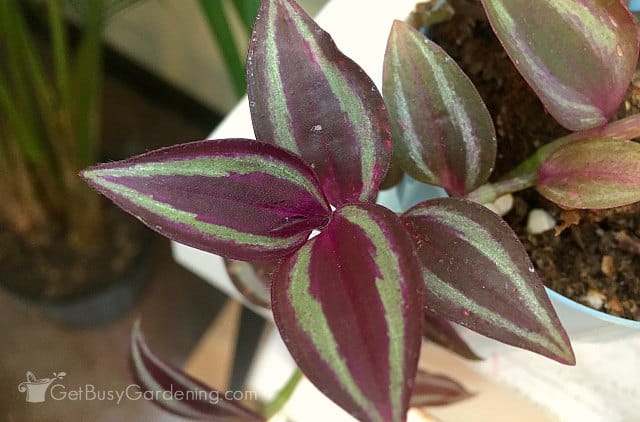
Different Wandering Jew Varieties
There are a whole bunch of different types of tradescantia plants you can grow, and they all require very similar care.
Here’s a list of the most common varieties. Be sure to take a look at the pictures throughout this post to see what some of them look like.
- Bolivian (while this is called “wandering jew”, it’s actually a different species)
- Bridal veil
- Red burgundy
- Purple fuzzy leaves
- Green fuzzy leaves
- Tricolor (‘Nanouk’)
- White/green variegated
- Purple queen (aka: purple heart)
Related Post: 17 Beautiful Purple Houseplants To Liven Up Your Home
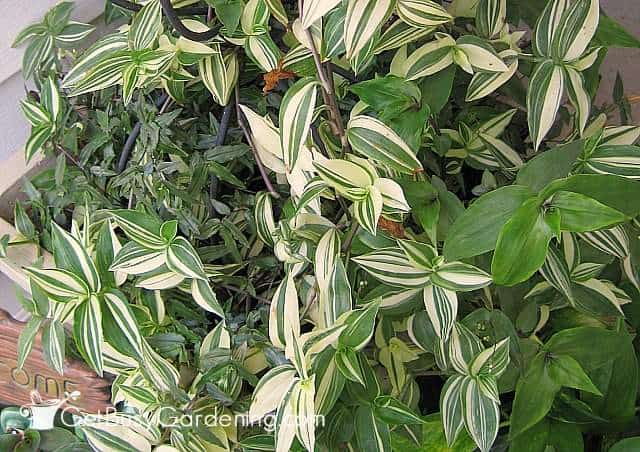
Toxicity
According to the ASPCA website, Tradescantia can be toxic to both cats and dogs. So, for your pet’s safety, it’s best to keep this one out of their reach.
Hardiness
Though they look extremely delicate, wandering jews are hardier than you might think, and can survive in zones 9-11.
They are not tolerant of the cold for very long, and will die at the first hard freeze if left outdoors. But, they can easily be brought indoors and grown as a houseplant through the winter.
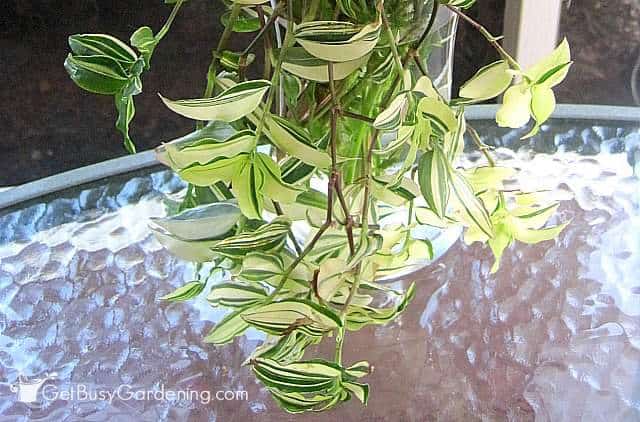
Where To Grow Wandering Jews
Before we get into the details of wandering jew plant care, it’s important to know a few key things about where to grow them to be successful.
Outdoors
I find it much easier to move my plants outside for the summer. I put them on my shady front step, where they thrive and get huge. I have two large containers with obelisks in them that are perfect.
As the vines grow longer, I train them to climb the supports. By mid-summer they are absolutely gorgeous, and I get tons of compliments on them every year.
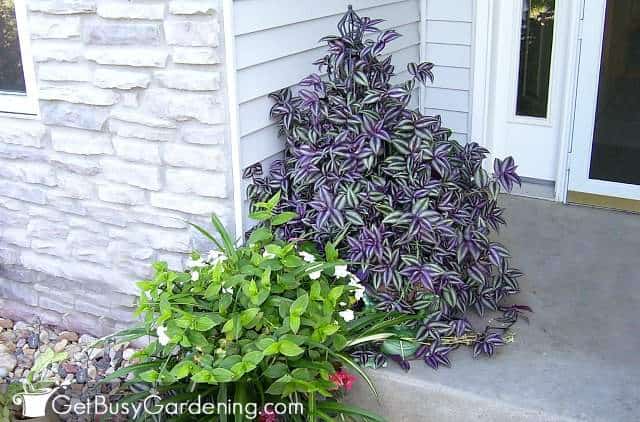
Indoors
Before frost hits in the fall, I bring my wandering jew plants inside, and keep them growing as houseplants.
Growing them indoors through the winter can be a bit difficult. But given the right care, you can keep your inch plant thriving year after year – which is totally worth it if you ask me.
If your plant is large, you could take cuttings and grow them in a vase of water. They won’t live that way forever, but if you keep the water fresh, they’ll be fine for several weeks.
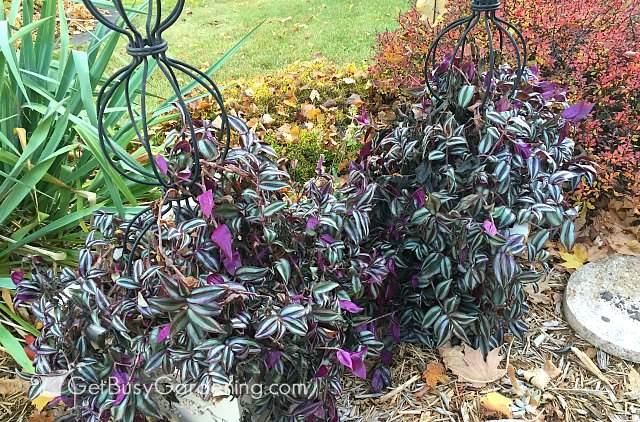
Wandering Jew Plant Care & Growing Instructions
Despite their differences, all varieties of wandering jew plants have the same basic care requirements. So you can follow these growing instructions for any type that you have.
Water
Tradescantias like to be watered regularly, and won’t tolerate their soil drying out for very long.
Keep the soil evenly moist (but never soggy) at all times. Give them a deep drink, and allow the excess to drain from the bottom of the pot.
They will tolerate being overwatered once in a while, but never allow the soil to stay wet for too long. If you struggle to give yours the right amount, I recommend getting a moisture probe to help you out.
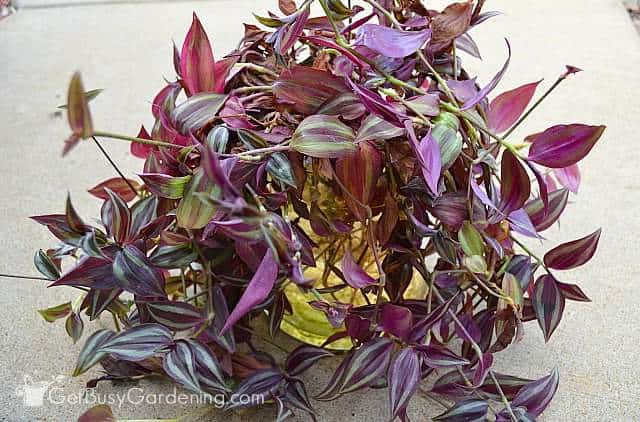
Humidity
Another key part of successful wandering jew plant care is humidity, and lots of it. When the humidity is too low, the leaves will start to turn brown and die.
This is the biggest issue with growing them indoors during the winter months, when the air in our home is super dry. So, it’s very important to keep the humidity as high as possible.
One easy way to increase the humidity level is to run a humidifier nearby. You should also keep an indoor humidity monitor next to your inch plant.
You could also put the pot on a pebble tray filled with water (don’t allow it to soak in it though), or even grow it in a small plant cloche or a mini indoor greenhouse.
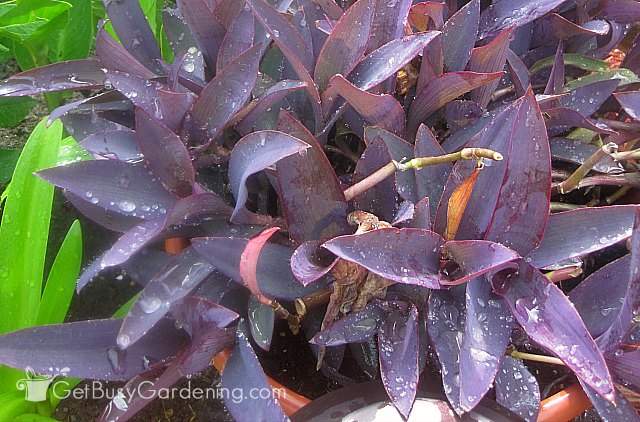
Light
Wandering jews are pretty picky about getting the right amount of light. They need a lot of light to maintain their bright color, but direct sun will burn their leaves (except for purple queen, they love full sun).
The ideal location for growing them indoors is an east or west facing window. That way it will get plenty of natural light in the morning/evening, and bright, indirect sun for the rest of the day.
When they don’t get enough light, their leaf colors will fade and look dull. So, if you don’t have a spot with lots of natural sun, then you should add a grow light.
But if you choose to move your inch plant outside for the summer, make sure to keep it in the shade or a partial shade location where it’s protected from the hot afternoon sun.
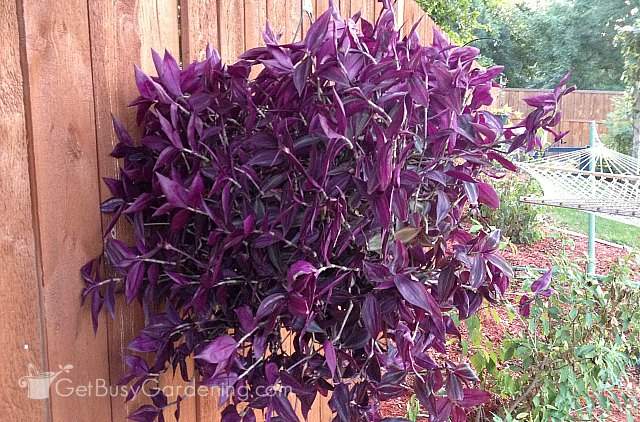
Temperature
Though wandering jews can tolerate short periods of extreme cold or hot temperatures, they grow best when kept between 50-80°F.
When it gets too far out of that range, the plant may start to suffer. It can handle warmer temps with shade, higher humidity, and consistent watering.
But if the forecast calls for frost or a short burst of freezing weather, either move it indoors, or cover it to protect the foliage from damage.
Soil
When it comes to soil, wandering jew plants aren’t picky, they will grow just fine in a general purpose mix.
But if you tend to forget to water (been there, done that), or the soil dries out too quickly, then mix in some peat moss, coco coir, and/or vermiculite to help it retain moisture.
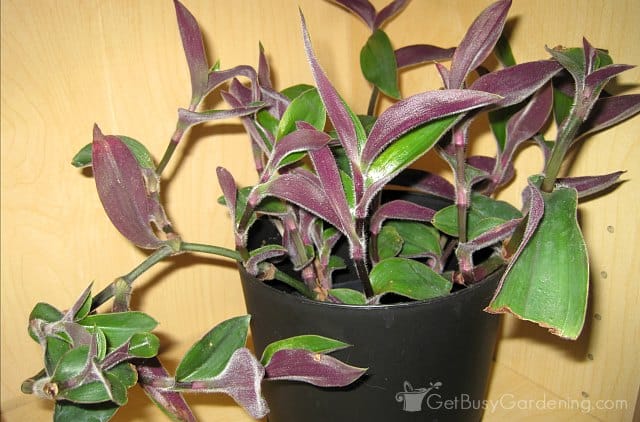
Fertilizing
Inch plants don’t really need to be fertilized as a part of their regular care. But of course they will benefit from being fed once in a while.
They only need it spring through summer, don’t fertilize them in the fall or winter. Winter growth is usually very weak and leggy, so you really don’t want to encourage that.
You can feed your plant monthly with a liquid fertilizer mixed at half strength. I recommend using organic plant food, rather than a synthetic one. Wandering dudes can be sensitive to chemical fertilizers.
A good organic general purpose fertilizer, or compost tea would work great. You could also add slow-release organic granules to the soil if you prefer doing that.
Fish emulsion and liquid kelp are also great options, but only use these outdoors (they can get a bit stinky when used indoors).
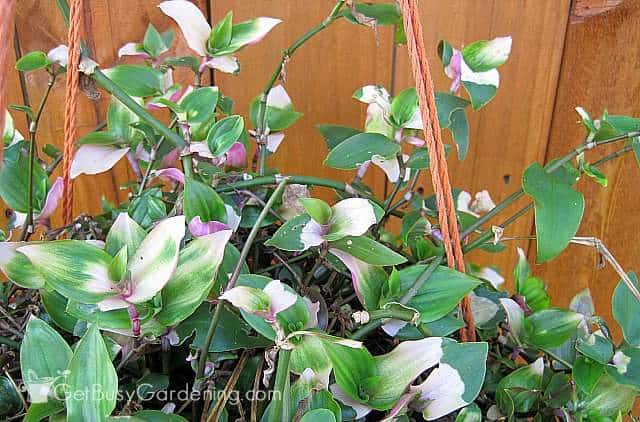
Repotting
When given the proper care and the perfect environment, wandering jews will fill a container fairly quickly. So you may need to repot them annually.
If yours becomes pot-bound or you see roots either coming out the bottom holes or growing over the top of the soil, it’s time to size up.
Choose a container that’s 1-2″ larger than the current one, and replant it at the same depth.
Wandering Jew Plant Flowers
Fertilizing can also help encourage blooming. Wandering jew flowers are pretty small and insignificant, and not all varieties look the same.
The flowers can be purple, pink, or white, and it’s always fun to see them. Sometimes they will even bloom during the winter, which is a welcome surprise.
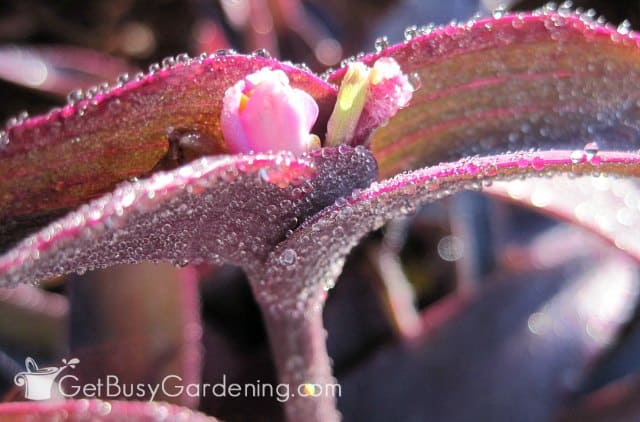
Pest Control
Bugs aren’t usually an issue when growing wandering jews outdoors. But spider mites, aphids, and fungus gnats can become a problem indoors.
To fight houseplant pests that infest the leaves, I recommend using neem oil, which is a natural pesticide.
I also like to use a mixture of 1 tsp mild liquid soap per 1 liter of water, and spray it on the leaves to kill the bugs. Insecticidal soap or horticultural oil also work great.
If you see gnats flying around your inch plant, allow the soil to dry out a bit more between waterings. You can also use a yellow sticky trap to help control them.
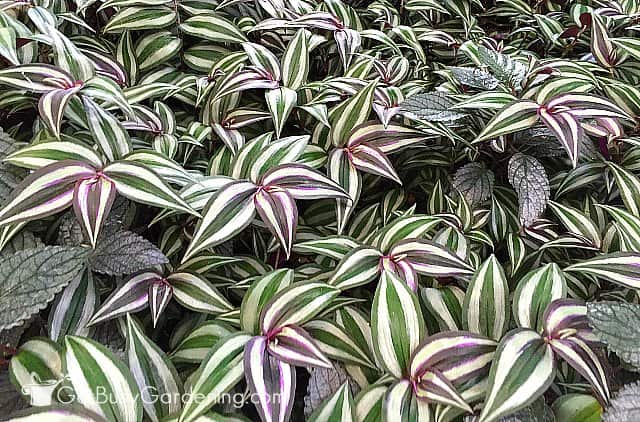
Pruning
It’s a good idea to make pruning a part of your wandering jew plant care schedule. Doing so will keep the vines compact and thick, giving it an overall fuller shape.
Trimming them encourages new growth, so it’s best to do it during the spring and summer months only, to avoid legginess. You can prune off dead and dying stems and leaves at any time.
For precision cuts, I recommend using bonsai shears or a micro-tip snip. You may also want to wear gloves, as the sap can be irritating for people with sensitive skin.
Learn more and get my detailed step by step wandering jew pruning instructions here.

Tips For Propagating Wandering Jew Plants
Wandering jew plants are super easy to propagate. Take cuttings that are 3-4″ long, and include a couple of leaf nodes.
Dip the cut ends into rooting hormone, then stick them in moist soil. Don’t allow the soil to dry out, and keep the air around the cuttings humid. A propagation chamber makes this simple.
They are also simple to root in a vase of water, and you’ll start to see new roots in a matter of days. I like to use a clear vase so I can see when the roots start to form.
Learn more in my step by step guide for how to propagate a wandering jew plant here.
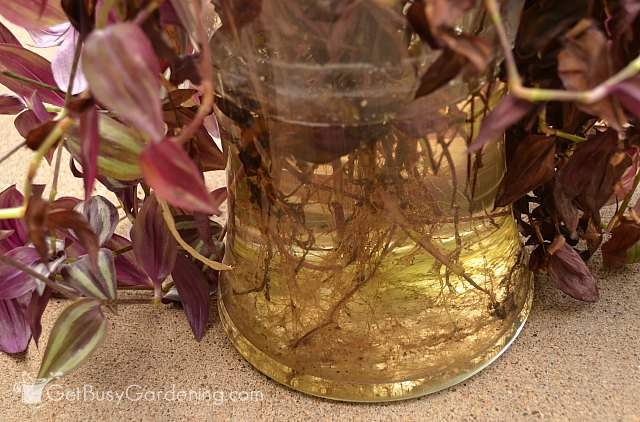
Troubleshooting Wandering Jew Plant Care Problems
It’s super easy to grow wandering dude plants outside, especially when it’s humid. But growing them indoors is a whole different story.
Most of the problems you’ll have with indoor care will be due to inadequate water, light, and/or humidity.
Weak, Leggy Growth
This is very common during the winter months, and is caused by a lack of light. Check the location of your wandering jew to ensure it’s getting the right amount of sun, or add a grow light.
Leaves Look Dull & Faded
Dull, faded leaves can be caused by too much light, not enough light, or a bug infestation.
Outdoors keep them in a partial to full shade location, and indoors give them bright, indirect light.
Another possible culprit is pests. Inspect the leaves for bugs and treat any insect infestation right away.
Brown Leaves
The leaves tend to turn brown due to lack of water or humidity. Make sure to keep the soil evenly moist at all times, and mist them regularly if the air is dry.
Also, as Tradescantia plants age, they tend to start dying out in the middle. When this happens, you can prune the vines and dead leaves to refresh the plant.
Learn more about what causes brown leaves and how to fix them here.
Yellow Leaves
When the leaves turn yellow, it’s almost always due to overwatering. Check the soil to make sure it’s not wet or soggy.
If it’s too wet, then let it dry 1″ down before watering it again. Use a moisture gauge to help you get it right.
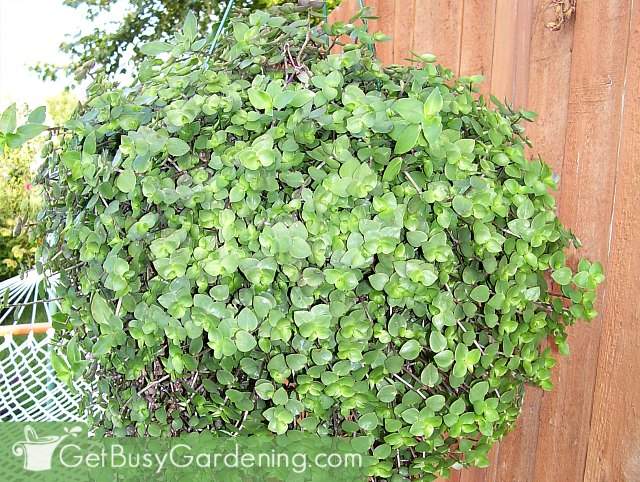
FAQs
When given the proper care, wandering jews are not hard to grow. They can be challenging as houseplants however. So for best results, put them outside during the summer, and overwinter them indoors.
A wandering jew can be either an indoor or an outdoor plant. If you live in zones 9-11, you can grow it outside all year. Otherwise, you’ll need to bring it inside during the winter.
You should water your wandering jew plant only when it needs it, rather than doing it on a set schedule. Check the soil weekly, and give it a deep drink when it feels dry 1″ down.
Wandering jews like full to partial shade rather than sun, especially in hot climates. Indoors they need lots of bright, indirect light.
You can make your wandering jew fuller by pruning it regularly during the spring and summer months. Simply cut the vines to the desired length, then they will branch out and come back much fuller.
If you want to learn all there is to know about maintaining healthy indoor plants, then you need my Houseplant Care eBook. It will show you everything you need to know about how to keep every plant in your home thriving. Download your copy now!
More Houseplant Care Guides
- How To Care For Indoor Palm Trees And Plants
- How To Care For Rubber Plants: The Ultimate Guide
- How To Care For A Pothos Plant (Devil’s Ivy)
- How To Care For A Money Tree Plant (Pachira aquatica)
- African Milk Tree: How To Grow & Care For A Euphorbia trigona Plant
- How To Care For Foxtail Fern (Asparagus densiflorus ‘Myers’)
Share your wandering jew plant care tips in the comments below.


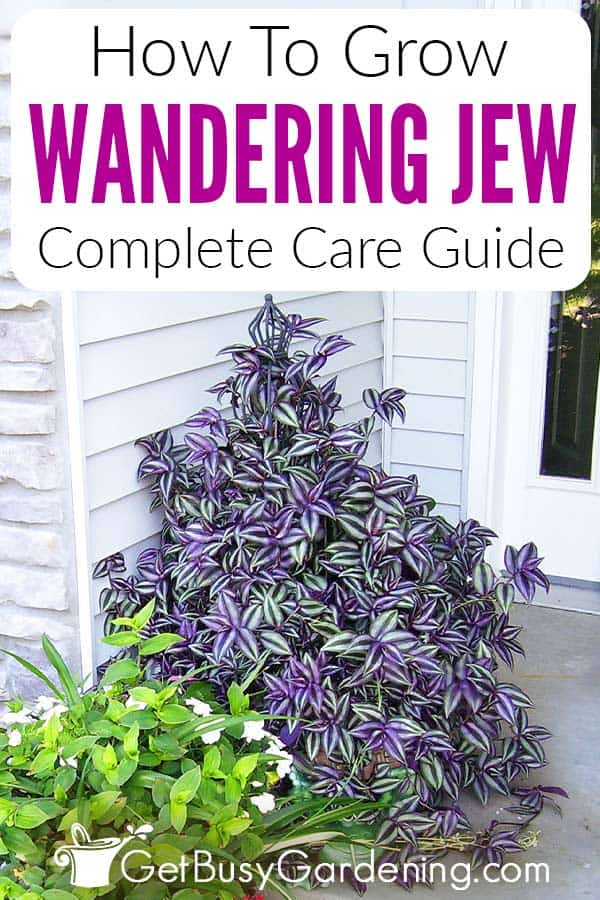

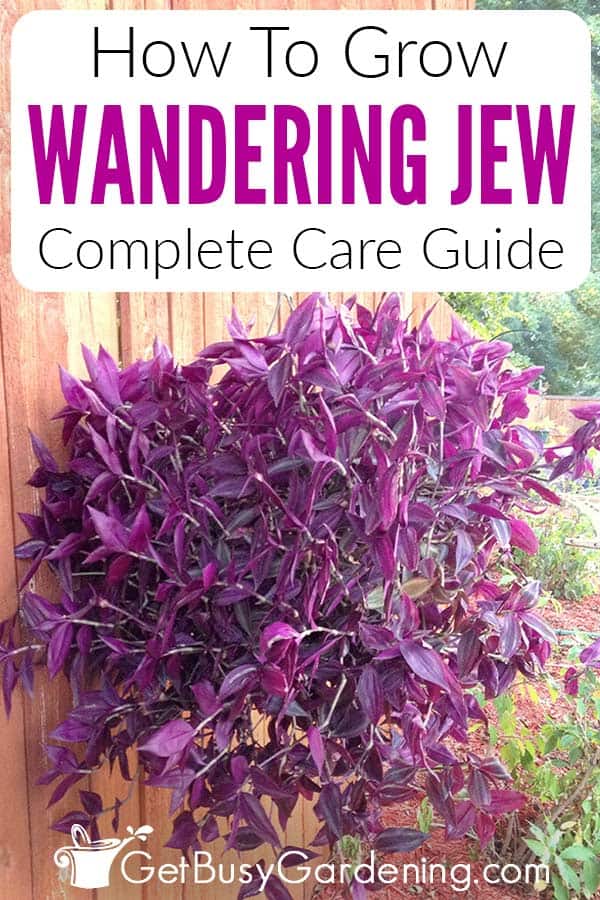
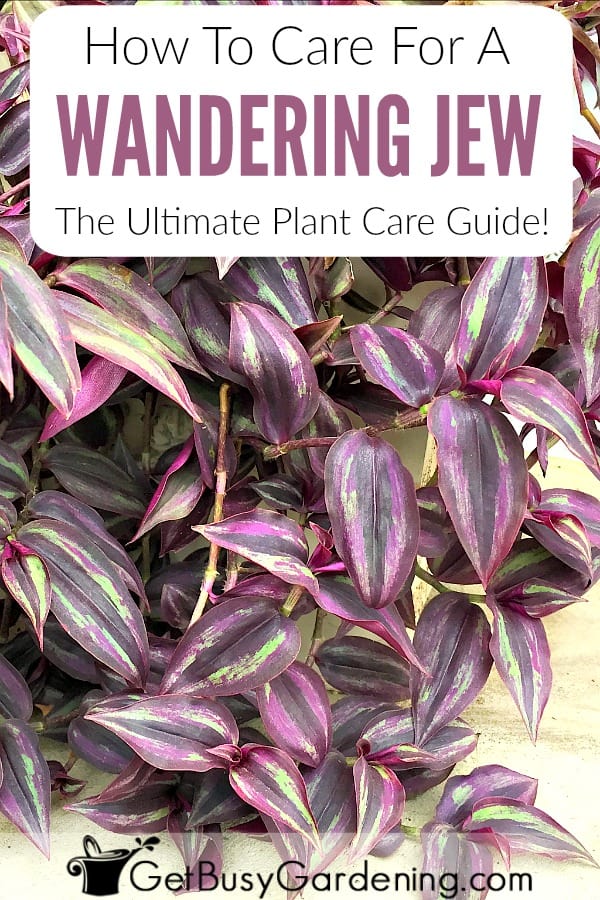



Mary Carter says
Are wandering dude plants poisonous to animals, in particular, to cats? Thanks for the info.
Amy Andrychowicz says
Yes, some varieties can be toxic to pets, here’s more information from the ASPCA website about it.
Donna Doeberling says
I have a wandering Jew that I got from my 22year old grandson when he was in preschool. I neglected it and then I noticed its leaves getting smaller and smaller. I saved one cutting which I have in a glass. Is there a way to bring it back . It has sentimental meaning.
Amy Andrychowicz says
The small leaves on your wandering jew plant tells me that it’s likely not getting enough light, and it might also have been overwatered. So make sure to give it plenty of bright, indirect light, and never let the soil become soggy or completely saturated for any period of time. Good luck bringing it back!
Tom Amato says
20 years ago my mother gave me a single purple wandering jew as a housewarming present, I still have it … and 10 of its offspring!… Mom passed on a few years ago and I struggle to remember her tips… yours are a nice refresher, thank you! I live in Western NY, so they are outside all summer and winter wherever I can find room in the house! One question I have is, the three that I have in my living room during the winter, on a table about 3 feet from a large west facing window, seem to grow exponentially in the winter… by now (january) they are filled with 8-10 shoots each 3-5 ft long reaching towards the window… each shoot full of beautiful leaves! I turn them 180 degrees every 2 weeks or so and they all re-angle themselves to the window like they are reaching to go outside! should I cut these long shoots back, even though they are the healthiest looking ones on each plant? I look forward to your help!
Amy Andrychowicz says
Wow, how wonderful! The fact that the new stems are reaching for the window means they’re not getting enough light. You could try adding a grow light to supplement, or move them closer to the window to see it that helps. You don’t need to cut the leggy growth off, but you certainly could if you want. I usually wait to cut mine back until I move it outside in the spring, then I root the cuttings and use them to fill in the empty spaces in the pot, if necessary.
Loretta Styles says
This was very helpful, everything was true and easy to follow. I was wondering what would make a purple Jew revert to being green? I love my purple ones and now they are all plain green : if anyone can explain….
Amy Andrychowicz says
Thank you, happy to hear you found this article so helpful! Purple or variegated wandering jew plants will revert to green when they don’t get enough light. So, the best way to get their color back is to make sure they get bright, indirect light. That’s easy outside, but indoors you may need to get a grow light.
Christopher Eason says
Hi I just got one today in a 2inch pot I have always liked this plant I hope I do well with it when should I take it out of the 2inch pot
Amy Andrychowicz says
Once you start to see roots growing out of the drainage holes, then you can pot up your baby wandering jew plant. 🙂
Cheryl says
I have been having a hard time getting my Wandering Jew back to her old glorious self again. I changed her potting soil, made sure it was nutritious rich soil and even added some more fertilizer to it to be safe. so I put her outside hoping that the fresh air will help after being couped up inside all winter. Would maybe adding some coffee grounds help boost some growth? What originally had happened to her was her roots ended getting infested, but I wasn’t sure what insect it was because it was after I transplanted her and used this potting soil I had gotten from “a store I will not mention”. Then I noticed months going by and she was just getting terribly ill looking and it was winter at this point and I wasn’t sure what to do so I had my son bring me some of his soil from his supply. What was left of her has so far been doing fair but struggling, I’m trying to encourage growth. Should I just put her into a jar of water? I’m at a loss 😫🥺… I want to save her, can you give me some Tips?
Amy Andrychowicz says
Oh no, sorry to hear that your wandering jew is not doing very well. It can be tough to keep them thriving indoors through the winter, since they like lots of humidity and bright, bright light, which is hard to create indoors. If the roots seem strong, I would move it to a full shade location outside and let it recover through the summer. You should start to see healthy new growth in a month or so. To give it a boost, you can pinch or prune the tips off the stems to reinvigorate it. However, if it’s overly leggy, and the roots/stems aren’t looking good, then you can take cuttings and root them in soil or water. Sometimes I find it easier just to take healthy cuttings and start them over in the spring. They grow very fast, so you should have a full and beautiful plant again come fall. 🙂
joann schuzer says
Can I add several starters of a wandering jew in 1 pot? Is so does size of pot matter?
Amy Andrychowicz says
Yes, you can add several small wandering jews into one pot, they don’t mind being crowded. Just choose a pot that is large enough that the plants will fill it nicely.
Jeff says
How long will these vines grow, indoors? I have a 15 foot tall wall to cover (and good indoor conditions—the right light and humidity, so that won’t be a problem). Will these vines grow that long?
Amy Andrychowicz says
Wandering jews are not technically vines, they are more like a ground cover in their native habitat. The longest mine ever get is about 3-4′ long, so I don’t think this would work to cover your wall. Instead you could try a large ivy, or pothos.
Rebecca says
How long is too long for the hanging branches and leaves? How do I know it’s time to cut it back? I’d prefer not to unless it is harmful to let them grow too long, as it cascades off of a tall dresser and looks healthy
Amy Andrychowicz says
As long as your wandering jew looks healthy, and you’re happy with the shape, then there’s no reason to prune it.
Rebecca says
Thank you!
Amy Andrychowicz says
You’re welcome!
Meghan L says
I’ve got the pretty classic purple and silver wandering jew variety, it’s fairly new and its in a hanging pot indoors where it get’s a good amount of sun daily. We bought it before it started hanging with the belief that as it grew it would drop down and become a hanging plant. The only issue I’m having is that it’s growing straight up!! It’s climbing instead of falling! HELP! How can I make it hang? It’s also fairly leggy and I would love to make it a smidge thicker. Thanks!
Amy Andrychowicz says
It sounds to me like your wandering jew may not getting enough light, that’s why it’s grown so leggy. They will naturally trail over the top of a hanging basket once the stems grow too long for them to stand up on their own, so there’s nothing you can really do to force it. If you regularly pinch off the new tips, that will force your plant to grow fuller and thicker, rather than continue to get taller. You could also try pruning it back if you’ve never done that. Pruning also encourages branching. Good luck!
VlCook says
My deep purple plants have brown/gray legions all over the leaves. It has gotten so bad that I think the plant is dying. What could this be? i live in south east Texas. is this fungus or mold or an insect? I have these purple plants in several areas and whatever this is seems to be moving to all of these plant.
Amy Andrychowicz says
It’s hard to tell for sure from the description. Most of the time, brown spots on tradescantia leaves are caused by improper watering (over or under watering). Wandering jews are very prone to root rot when overwatered, but love lots of humidity. So, if it’s too dry for them, the leaves will start to turn brown. This could also be caused by too much sun, which can burn the leaves. To rule out bugs, take a close look at the damaged leaves, and see if you spot any bugs (look under the leaves too). Most insects that cause that type of damage will be easy to see when you inspect the leaves.
Melissa says
I add a little bit of cinnamon to the surface of the soil. This helps keep fungas gnats away. Cinnamon is a natural fungicide. You just water it right in. It doesn’t hurt the plant. It works great for me. I do this with all my houseplants.
Amy Andrychowicz says
Thanks for your tip. I haven’t tried using cinnamon myself, but always good to hear it works for others!
Rose says
Thanks so much for your great advice! My green and white beauty has many leaves turning brown this September, after an amazing summer of growth as an indoor plant in the UK. I was worried to see all these brown leaves. I feel more confident with pruning, raising humidity and checking for dry soil. Thank you!!
Amy Andrychowicz says
Oh no, sorry to hear your tradescantia is struggling! Glad to hear that you found this article helpful, thanks for sharing! 🙂 You’re welcome! Hope your plant recovers quickly.
Barbara Sabin says
Amy,
I have a Purple Heart, I bought it in the spring and she lived in full sun all this summer. She has grown and has beautiful little flowers.I live in New Jersey and know I will have to bring her in in the winter. My problem is I don’t have a window east or west, she will live by window with light but not direct sun. Also, next year will she acclimate to the change from inside, with no direct sun to outside direct sun.
Amy Andrychowicz says
Great job getting your purple heart to grow so well this summer, how fun! That variety of tradescantia does need a lot of light. So, if you can’t put it in a sunny window through the winter, then I would recommend getting a grow light for it. If purple heart plants don’t get enough light, their color will fade, and they will start to grow leggy. Bu, it will pop back pretty quickly after you move it back outside in the spring. Just be sure to slowly transition it back to growing in full sun again, or the leaves could get sunburn (BTW, this is true even if you use a grow light).